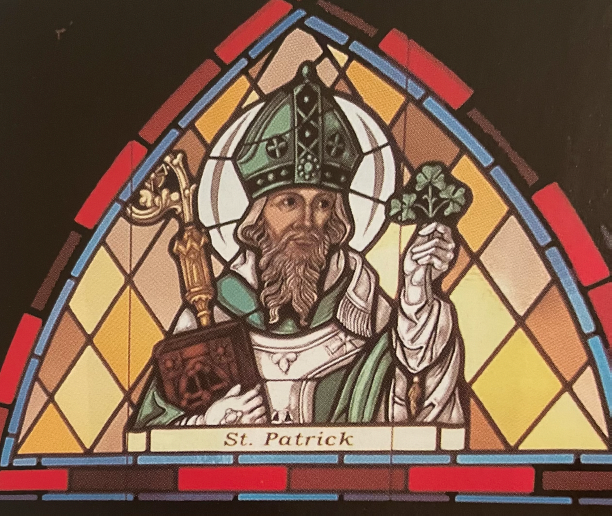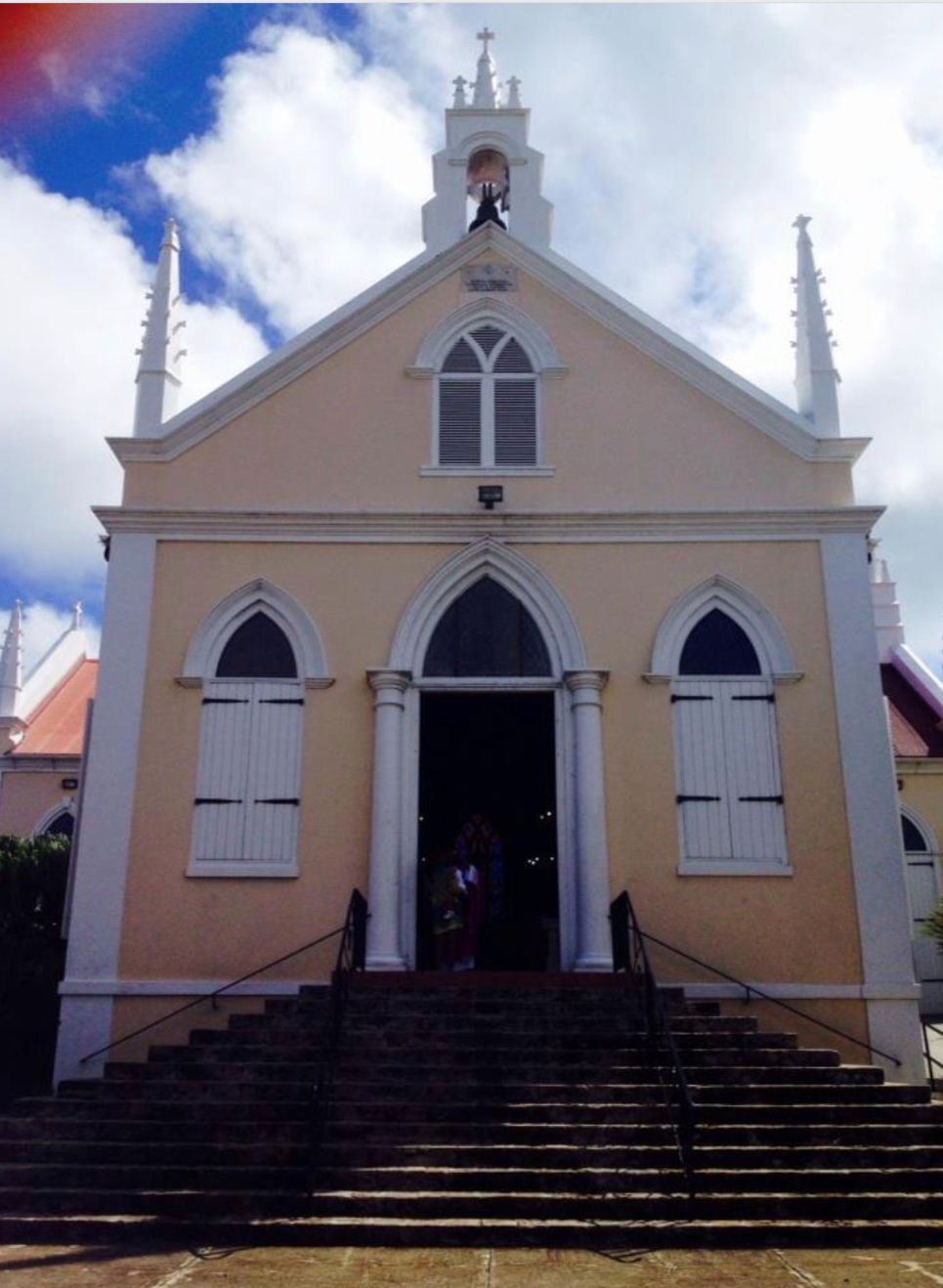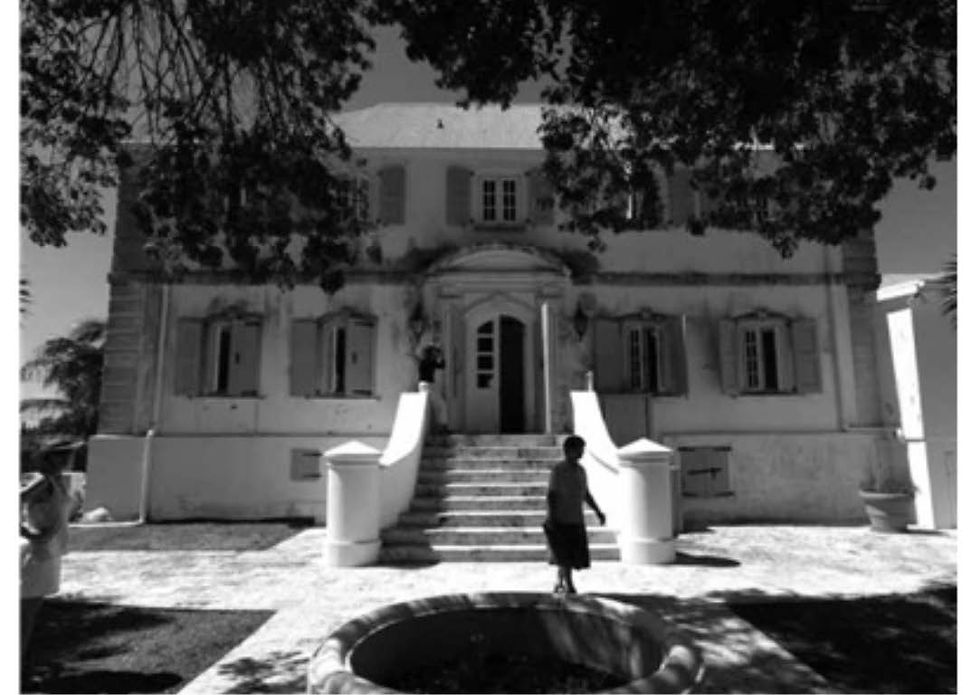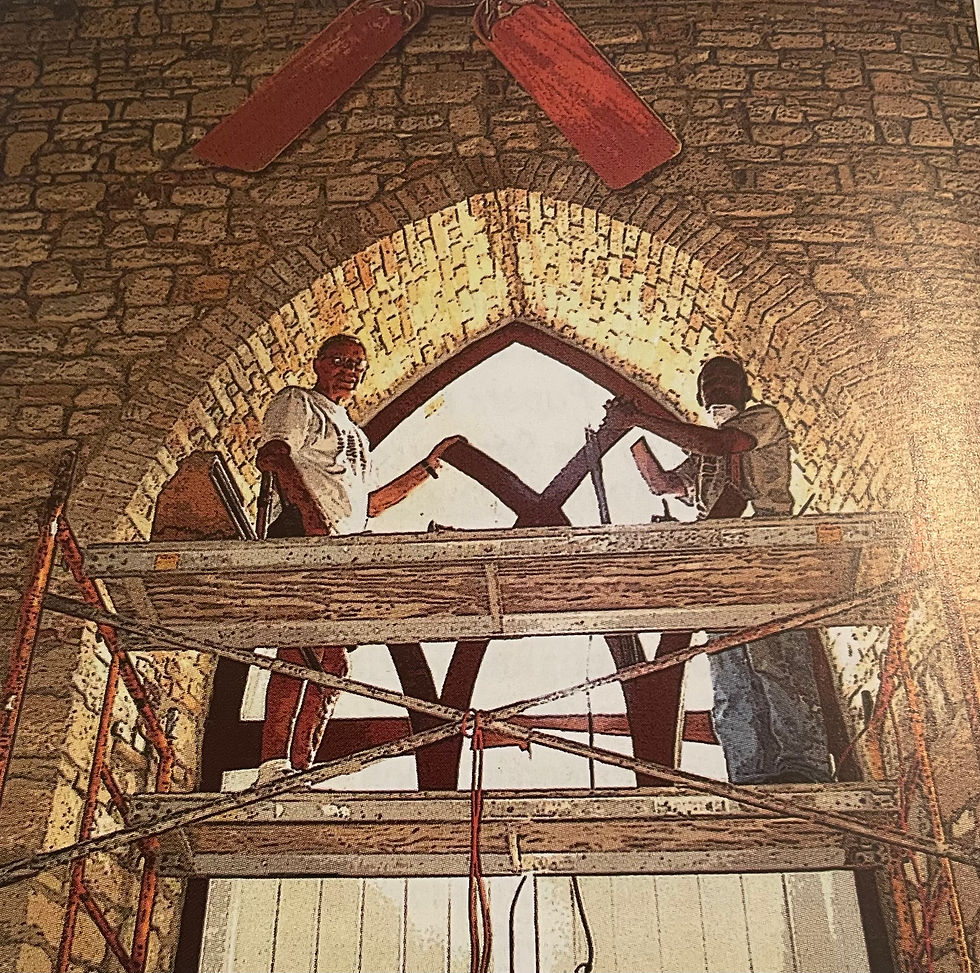A Window Into the Past
- Mark Dworkin
- Jun 19
- 6 min read
Updated: Jun 23
John F. McKeon

I first arrived in St. Croix in 2012. As my wife Stephanie and I share an interest in old churches, our first stop was a visit the Holy Cross Church on Queen St. in downtown Christiansted. My interest lies more in the architectural than the spiritual. The wood and stonework crafted by artisans and masons intrigue me.
One Sunday morning we walked into the vestibule to get a closer look at the nave and altar. Not wanting to disrupt the service, we immediately sat down in the nearest empty pew, facing the altar. Looking up, my eyes focused on the prominent stained glass window featured to the left of the altar.The window came as quite a surprise!
Let me explain; above was a beautifully leaded glass representation of a Catholic Bishop dressed in green. His mitre ( a tall pointed head covering) was emerald green and he held a bouquet of shamrocks in his left hand. As the shade of green and the trifoliate plant are both national symbols of Ireland, I was perplexed as to how and why they were on display down in the West Indies! This is where our story begins.

Catholicism permanently came to St. Croix as a result of Nicholas Tuite. Nicholas Tuite was the son of Richard Tuite of Tuitestown in County Westmeath, Ireland. The family left Ireland as part 2 of the ‘Wild Geese’ (1) in 1691, when many were killed in the Williamite Wars.(2) He was born an 1 2Irish Catholic on the British Protestant Island of Montserrat and relocated to St. Croix in order to practice his faith under what he hoped would be a less oppressive regime.
In 1752, Tuite petitioned the Vatican’s missionary arm of the Holy See in Rome to establish a Mission on the Island of St. Croix. Rome agreed to his request, however, Tuite still needed the Danish government’s permission. Many of his resettled farmers and laborers were Catholic. Tuite requested that the governor permit freedom of worship for the Catholic plantation workers. In 1754, the King of Denmark granted Tuite permission to build churches, freely practice Catholicism, and supply as many Catholic priests as needed, provided none were of the Jesuit Order (3)
In 1755, Tuite established Holy Cross, the first permanent (4) Roman Catholic church in Christiansted. The church was administered to by priests of different nationalities speaking both English and French. Considering the sectarian times, the permission of the Protestant King of Denmark to grant religious freedom in St. Croix was remarkable. This decree permitted the arrival of a Catholic community under a Protestant monarch. The Danes believed that St. Croix was in dire need of colonists, and this changed the dynamic going forward. It produced a constant increase in Catholics from immigration, and produced many conversions to Catholicism.
The term Wild Geese is used in Irish history to refer to Irish soldiers who left to serve in continental European 1 armies in the 16th, 17th and 18th centuries. The Williamite victory in the war in Ireland ensured closer British and Protestant dominance over Ireland. Until
the nineteenth century, Ireland was ruled by what became known as the "Protestant Ascendancy," the mostly Protestant ruling class. The majority Irish Catholic community and the Ulster-Scots Presbyterian community were systematically excluded from power, which was based on land ownership. The Society of Jesus has been the subject of various accusations of bias throughout their history, often stemming
from their significant influence in education, missionary work, and intellectual circles. During the French Period 1650-1733 a modest Catholic Church was established in Le Bourg (Christiansted) along
with several chapels in the countryside.Funds and support were lacking, at times there were no priests at all on the island. After repeated failures the French departed from St. Croix in 1696 . Catholicism remained the official faith until 1733 when the Lutheran Danes purchased the island. The Cultural History of the American Virgin Islands and the Danish West Indies: A Companion Guide Paperback – January 1, 2018 by Arnold R. Highfield (pg 111)

In 1756, Tuite also oversaw the opening of his estate house at Sion Farm. His plantation in the center of St. Croix is presently the residence of the Deputy Governor of The US Virgin Islands.Tuite was heavily involved in land speculation. His wealth in the West Indies was generated not only through sugar, but also animal husbandry and crop cultivation. The Irish planter’s consolidated acquired holdings were aquired through ‘Kinships’ (5)
5. A network of social relationships based on real or perceived family t ies, including blood, marriage, and adoption, 5 which shapes social organization, roles, and obligations within a society.
In 1848, the first renovation and addition to the present church, was built, and an addition was erected over the cemetery on the North side of the Church. During the enlargement the cornerstone was placed, inscribed in Latin ; ‘The Holy Catholic Apostolic Church of the Holy Cross erected in the Year of our Lord 1849.’ As the years passed some needed repairs and improvements were made. The Baptistry on the South east corner of the Church, and later the altar boys and priests’ sacristy were added, an aluminum roof was added and the Church’s exterior was freshly painted. Eventually, a new ceiling was installed, the interior painted and the flooring in the sanctuary restored. In 1956, a fire engulfed the Church, destroying the entire contents of both sacristies. The murals, the entire ceiling, and the historic pipe organ were destroyed. In 1975, a new roof was installed along with new windows and doors.
The Window
In 1997, the Church required major hurricane recovery reconstruction. It had survived a series of hurricanes that hit the island in past decades of which Hurricanes Hugo (1989), and Marilyn (1995) were the most destructive.

The stained glass window installation in the church was started in mid-March , 2002 under the direction of Heimir and Company Stained Gass studio of Clifton New, Jersey. The windows were sent in two shipments, the first in March and the second in April. The project was finished by June. The installation of stained glass windows in any masonry rough openings is no simple task. The masonry openings in Holy Cross church’s in some cases date back to 1755 and 1858 making it significantly more difficult.
(Photo of Mr. Leonard Schwan and Mr. Fazal Donaie preparing for the window installation). (6)
The parish rectory and McAlpin Hall were renovated along with the addition of a new Good Shepherd Center and were all welcome and necessary innovations. Presently There are three communities of nuns in the parish: the Sisters of the Good Shepherd, the Missionaries of Charity and the Dominican Sisters of the Immaculate Conception. The St. Mary School which still serves the parish. (7)
This brings our story full circle. I was very pleased to confirm that it truly was St. Patrick, represented in the window. Historically, St.Patrick was captured and taken to Ireland as a slave, Lived as a slave and later escaped. He believed that he had been chosen to return to Ireland, and was later ordained a bishop. Patrick converted pagan Irish chieftains, resulting in thousands of conversions and erected churches throughout Ireland. As a result even kings converted to Christianity. He used the shamrock to explain the trinity which is still the national symbol of Ireland, exactly as preserved in the stained glass.
Both St. Patrick and Nicholas Tuite are connected through the two historically oppressed islands of St.Croix and Ireland. Both also have complicated, opposing and intertwining histories. Patrick was a slave, and a churchman. Tuite was a planter, a slave trader, a churchman, and a merchant banker. Tuite died in 1772 at the age of 67, Patrick in 461AD. With a little research both came back to life on a Sunday morning, in a church nave in Christiansted, St. Croix.
Historian John F. McKeon lives on St. Croix and Southampton NY. He holds degrees from Trinity College Dublin,(MPhil with Distinction). and St. Joseph's University in NYC (Summa Cum Laude Degree) East Asian History with a Philosophy Capstone Minor in Labor, Class and Ethics. John earned a certificate from the Oxford University Epigeum Research Integrity Center. He is a member of the Society of Virgin Island Historians.
6. The author was fortunate to discover and obtain an out of print work detailing t he window replacement project on 6 the Church.by the Rev. Alfred Bradley and Rev. Patrick Lynch. Both former Pastors of Holy Cross. Holy Cross Roman Catholic Church: History of the Church and Lives of the Saints in the Commemorative Stained Glass Windows Hardcover – January 1, 2004 by Patrick Lynch (Author), Alfred Bradley (Author)
7. Web 2025 https://hccstx.org



